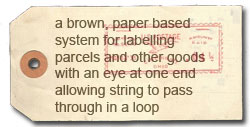There’s an interesting post over on the conference.archimuse.com blog where Jennifer reports that research they’ve been undertaking on the use of the steve.museum tagger shows that greater than 75% of all new tags given to images in the experiment weren’t words originally associated with the image by museum staff when cataloguing.
 That’s a pretty extraordinary statistic, and says something deep about the ways in which museums interpret and communicate their assets. I’m sure Jennifer will be drawing her own conclusions from this, but the first and most obvious response (without having read the research in depth, so shoot me down if you have..!) is either that museums are badly out of touch with how their users interact with their assets, or that findability isn’t that important to curatorial staff. Neither of these is a particularly positive conclusion to draw.
That’s a pretty extraordinary statistic, and says something deep about the ways in which museums interpret and communicate their assets. I’m sure Jennifer will be drawing her own conclusions from this, but the first and most obvious response (without having read the research in depth, so shoot me down if you have..!) is either that museums are badly out of touch with how their users interact with their assets, or that findability isn’t that important to curatorial staff. Neither of these is a particularly positive conclusion to draw.
Ultimately of course, this comes down to a user-focussed (or not) approach, both to the way that assets are presented online, and the way that folksonomies and taxonomies are applied to collections in-house. Understanding the end-users of your product is one of those holy grail things which so many people (including me) preach about, and yet is missed time and time again. So often, it’s the organisational perspective which ends up being presented, and not that of the user. Inevitably, it’s users who end up losing out.
hey mike —
the 75% new tags number is consistent with the pre-tests done at The Metropolitan Museum of Art and in the beta version of the steve tager (reported in detail elsewhere (see http://www.archimuse.com/research/steve.html)
what we’re revealing is a significant semantic gap between the language of tagging and the language of museum documentation. my gut is that it’s reflective of the fact that art documentation is created by and for art specialists, not the general public. remembering my time in grad school, the LAST thing you talk about is the work itself!
if we agree that people search on what they tag, then yes, there’s a problem with access.
we’re testing that theory with search log studies (comparing tags to what people look for to see if they fill a gap). now that doesn’t tell us if searching is limited by what people hope they might find… but that’s a different question. i couldn’t believe the dearth of hard data about searching museum sites when i did the prototype study with Guggenheim log data.
seb’s work at the powerhouse is pointing us to ways that we can make tags and taxonomy work together in the museum space; we’re hoping we can add to that with what we learn at steve.museum.
/jt
Very interesting post Mike. Thanks.
Juha
jt – interesting point: “if we agree that people search on what they tag..” – my assumption would be this is the case. It obviously also depends on the familiarity with which the user comes to the web. For instance, I know (as uber-geek) how to search Google most effectively – not necessarily the harder stuff like url removal – but most effective use of keywords to get the results I am looking for. My mum probably wouldn’t, or wouldn’t persist in the way that I would. This in itself is an interesting usability problem.
Once you get out of Google and into the weirder backwaters of museum / site-specific search engines, the paradigm shifts again. Which is why I almost always use Google toolbar to “search within site” rather than rely on a (probably rubbish) internal search engine: not only do I know it’ll work but the usage is familiar, too.
I’m tangenting 🙂
It’ll be very interesting to see how this develops. It touches on so many things from usability to access to authority. I think it’s readily apparent (and hopefully widely recognised) that it’s badly broken, so any work done is going to help…
Mike, Jennifer,
I ran some tests on our PHM data set . . .
[ Mike edit: pesky long urls breaking my site! Try this: http://tinyurl.com/2clldc ]
We get a different result – mainly I think as a result of the different ‘type’ of collection and documentation style.
Next up I’ll blog the latest search data.
Seb